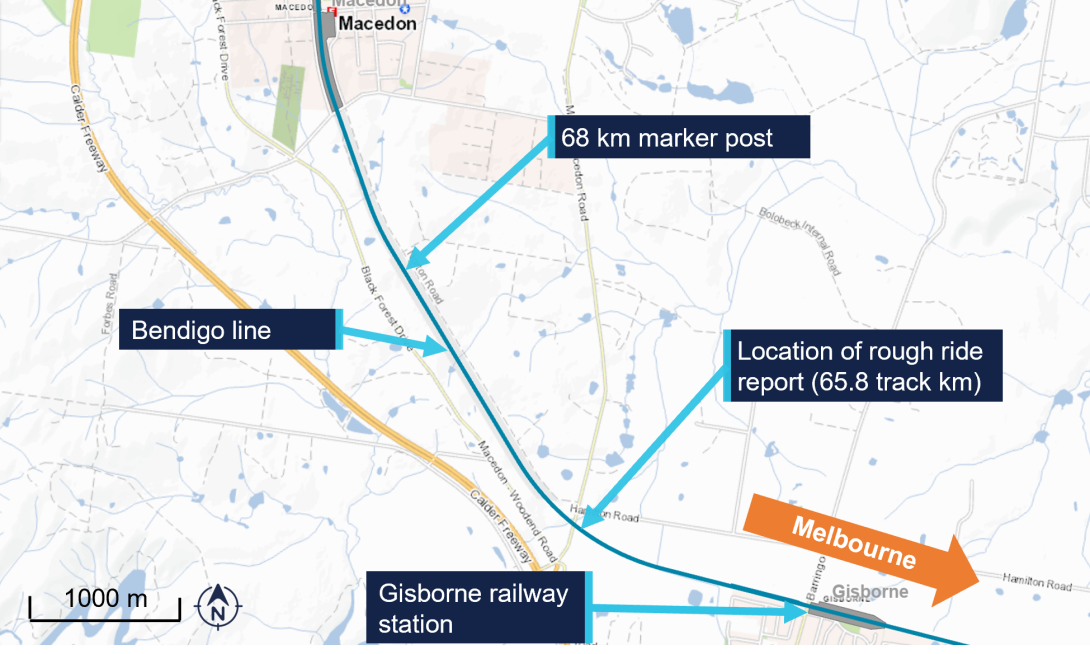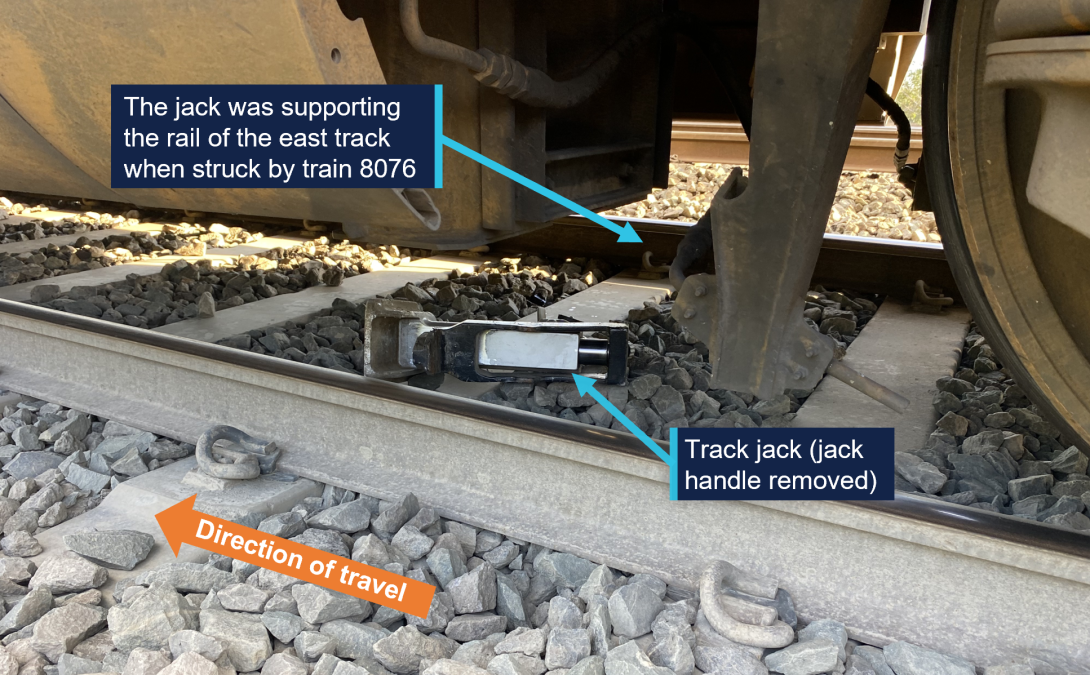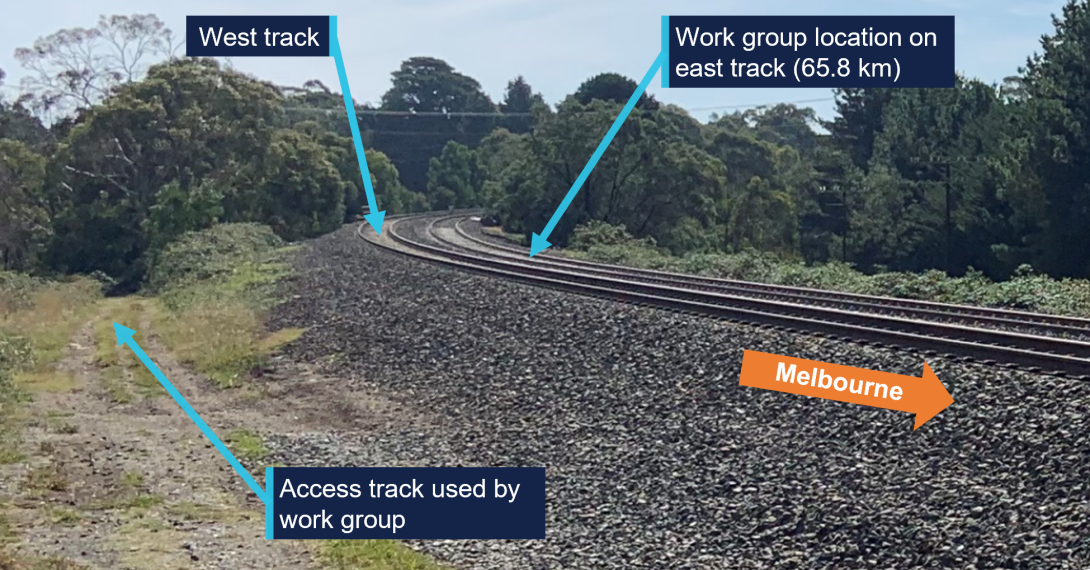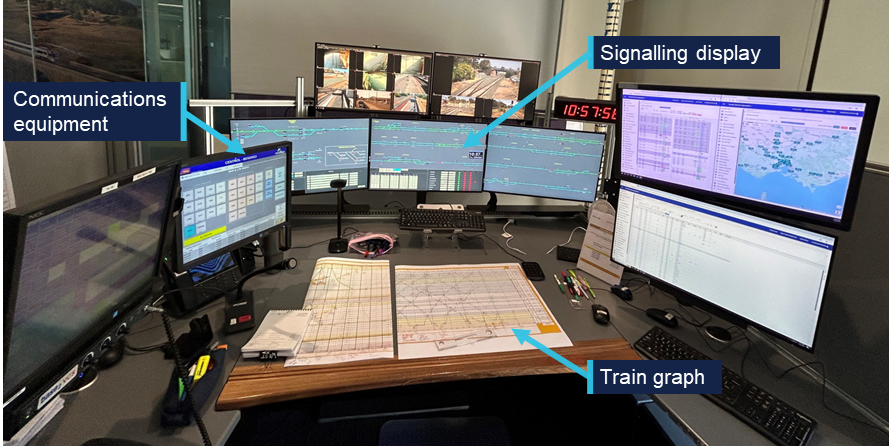This preliminary report details factual information established in the investigation’s early evidence collection phase, and has been prepared to provide timely information to the industry and public. Preliminary reports contain no analysis or findings, which will be detailed in the investigation’s final report. The information contained in this preliminary report is released in accordance with section 25 of the Transport Safety Investigation Act 2003.
The occurrence
Prior to the incident
At about 1549 local time on 11 March 2025, the driver of a V/Line passenger service from Bendigo to Melbourne, Victoria reported to V/Line train control (Centrol) that they had experienced a severe rough ride[1] at 65.8 track km[2] on the east track of the Bendigo line (Figure 1). The train was travelling at about 120 km/h when the rough ride was experienced. The maximum permitted track speed at the location was 130 km/h.
Figure 1: Location of rough ride report
Source: Vicmaps, annotated by the Office of the Chief Investigator (OCI)
The V/Line train controller overseeing the Bendigo line at the time reported the fault to the V/Line fault maintenance centre and implemented a 90 km/h speed restriction at the location.
It was common practice for train controllers to notate the train graph when advised of problems with the rail track. This provided train controllers with critical information regarding the state of the track and assisted train controllers when they were required to advise following trains.
At about 1610, the work group supervisor (WGS) of a track maintenance workgroup called the train controller to inform that they were departing Bendigo to attend the rough ride location and a track warrant[3] may be required. The workgroup consisted of the WGS, who was also performing the role of track force protection coordinator[4], and 3 other maintenance staff. The train controller advised the WGS that the rough ride report was for the east track.
At about 1641 the train controller called the WGS to advise that a V/Line train service had passed through the location at the restricted speed of 90 km/h without rough ride. The WGS informed the train controller that they were en route to the location and still intended to inspect the location. The train controller advised the WGS that, if a track warrant was required, there would likely be a 35 to 40 minute period after an ‘up’[5] train had passed.
When the WGS arrived at the rough ride location (65.8 km), they called the train controller to request a track warrant to attend to the track issue. The train controller advised the WGS that a VLocity train would be passing through the section at about 1740 and that a track warrant could be issued once it had been sighted clear of where they were working. In discussion, the WSG and train controller established that the limits of the track warrant would be between 65 km and 68 km. The train controller requested that the WGS call back once they had seen the VLocity go through.
At 1735 the train controller contacted the driver of the Echuca to Melbourne service 8076, to advise of the report of rough ride on the east line at 65.8 km and for the train to travel at no more than 90 km/h from 65.9 km to 65.7 km.
At about 1736 a relief controller took over from the train controller. The train controllers discussed the pending track warrant among other ongoing activities on the Bendigo line.
At 1741 the WGS who was at the 68 km mark called Centrol and advised the relief train controller that they had sighted VLocity train unit number 1291[6] go past. The train sighted was train 8033, the Melbourne to Eaglehawk service, travelling north on the west track. At this time, V/Line passenger train 8076 was on the east track at about 77 km and approaching the worksite.
In response to the sighting of 8033 the relief train controller issued the WGS a track warrant to occupy the east line between 65 km and 68 km from 1745 to 1815. Once the track warrant was issued, the WGS agreed with the relief train controller that traffic could continue on the west track.
At about 1745 the WGS informed the workgroup that a track warrant had been issued and that they could begin work. The WGS then began to drive from the 68 km mark to the worksite.
The incident
At about 1749, the driver of train 8076 sighted the workgroup about 240 m ahead, working at about 65.8 km. In response the driver sounded the horn and applied the emergency brake. The train was travelling at 80 km/h when the emergency brake was applied.
The workgroup cleared the track as the train approached. A track jack, being used by the workgroup, remained under one of the rails and was struck by the train. The train came to a stand about 70 m past the worksite. There were no injuries and the train remained on the rails. There was minor damage to the underside of the train.
Figure 2: Track jack under train 8076
Source: V/Line, annotated by the Office of the Chief Investigator (OCI)
After an initial inspection by the driver, train 8076 was driven at about 10 km/h to Gisborne Station where the passengers left the service.
Services on the east track resumed later that evening with an 80 km/h speed restriction between 64 km and 66 km.
Context
Location and rail infrastructure
Gisborne railway station is 64.2 km northwest of Melbourne. The worksite was 1.6 km west of the station (Figure 1).
The railway at the incident location consisted of 2 adjacent lines, referred to as the east and west tracks, both permitted bi‑directional running. The maximum permitted speed for VLocity passenger trains travelling along the east track was 130 km/h and on the west track was 160 km/h. The worksite was located on a track curve (Figure 3).
The rail land was leased by VicTrack[7] to Transport for Victoria[8] and sub‑leased to V/Line. V/Line maintained the track and managed train operations on the Bendigo line.
Figure 3: Work site location
Source: OCI
Centrol
Centrol was the train network control centre for V/Line services. Train controllers at Centrol were responsible for the safe running of trains and providing track access for infrastructure maintenance staff.
The room at Centrol used to oversee operations on the Bendigo line was equipped with signal panels that allowed train controllers to set signals and identify the approximate location of trains. Communication equipment in the room allowed train controllers to communicate with train and infrastructure maintenance staff. Train controllers used paper train graphs to record the location of trains and infrastructure maintenance staff (Figure 4).
Figure 4: Centrol train control room for the Bendigo line
Source: OCI
Further investigation
To date the following investigation activities have been completed:
- inspection of the occurrence location
- examination of train operational information
- interview of several parties
- collection of other relevant information.
The investigation is continuing and will include review and examination of:
- safeworking systems
- communication procedures
- risk management practices.
A final report will be released at the conclusion of the investigation. Should a critical safety issue be identified during the course of the investigation, the ATSB will immediately notify relevant parties so appropriate and timely safety action can be taken.
Purpose of safety investigations
The objective of a safety investigation is to enhance transport safety. This is done through:
- identifying safety issues and facilitating safety action to address those issues
- providing information about occurrences and their associated safety factors to facilitate learning within the transport industry.
It is not a function of the ATSB to apportion blame or provide a means for determining liability. At the same time, an investigation report must include factual material of sufficient weight to support the analysis and findings. At all times the ATSB endeavours to balance the use of material that could imply adverse comment with the need to properly explain what happened, and why, in a fair and unbiased manner. The ATSB does not investigate for the purpose of taking administrative, regulatory or criminal action.
Rail safety investigations in Victoria
Most transport safety investigations into rail accidents and incidents in Victoria and New South Wales (NSW) are conducted in accordance with the Collaboration Agreement for Rail Safety Investigations and Other Matters between the Commonwealth Government of Australia, the State Government of Victoria and the State Government of New South Wales. Under the Collaboration Agreement, rail safety investigations are conducted and resourced in Victoria by the Chief Investigator, Transport Safety (OCI) and in New South Wales by the Office of Transport Safety Investigations (OTSI), on behalf of the ATSB, under the provisions of the Transport Safety Investigation Act 2003.
The Chief Investigator, Transport Safety (OCI) is a statutory position established in 2006 to conduct independent, no-blame investigation of transport safety matters in Victoria. OCI has a broad safety remit that includes the investigation of rail (including tram), marine and bus incidents.
Terminology
An explanation of terminology used in ATSB investigation reports is available here. This includes terms such as occurrence, contributing factor, other factor that increased risk, and safety issue.
Publishing information
Released in accordance with section 25 of the Transport Safety Investigation Act 2003
Published by: Australian Transport Safety Bureau
© Commonwealth of Australia 2025

Ownership of intellectual property rights in this publication
Unless otherwise noted, copyright (and any other intellectual property rights, if any) in this report publication is owned by the Commonwealth of Australia.
Creative Commons licence
With the exception of the Commonwealth Coat of Arms, ATSB logo, and photos and graphics in which a third party holds copyright, this report is licensed under a Creative Commons Attribution 4.0 International licence.
The CC BY 4.0 licence enables you to distribute, remix, adapt, and build upon our material in any medium or format, so long as attribution is given to the Australian Transport Safety Bureau.
Copyright in material obtained from other agencies, private individuals or organisations, belongs to those agencies, individuals or organisations. Where you wish to use their material, you will need to contact them directly.
|
[1] The response of the vehicle to the physical geometry of track that is felt by the train driver.
[2] Track kilometre (track km) refers to the distance along a track from a known location. On the Victorian broad gauge network, the 0 km reference is Southern Cross Station in Melbourne. All references to km in this report are track km.
[3] A track warrant is an authority for unplanned infrastructure work activities.
[4] The person appointed to assess and implement worksite protection arrangements on site.
[5] Train travelling towards Melbourne.
[6] The train’s lead unit number, used to visually identify the train. Other train numbers quoted in the report are train describer (TD) numbers, which are 4 digit numbers unique to every journey a train makes in a day. Unit number 1291 was part of train 8033.
[7] VicTrack was a Victorian government owned organisation which owns Victoria’s rail land, buildings, infrastructure and rolling stock and leases those assets to the Department of Transport and planning (a Victorian government department). Those assets were then sub-leased to rail companies.
[8] Head Transport for Victoria was a statutory office established under the Transport Integration Act 2010.






